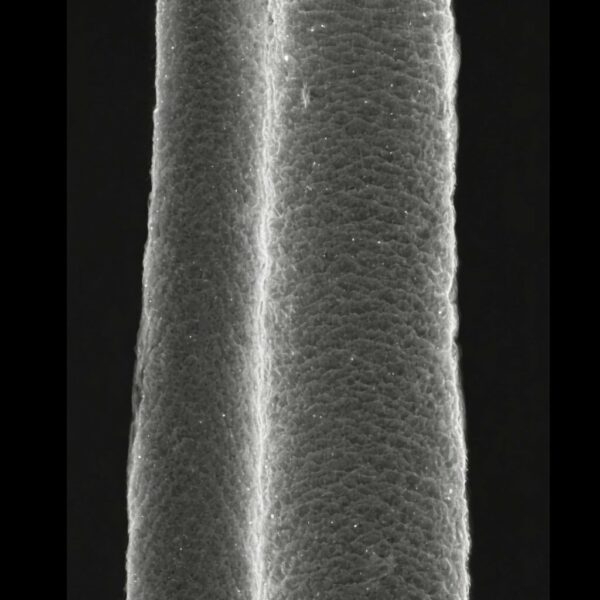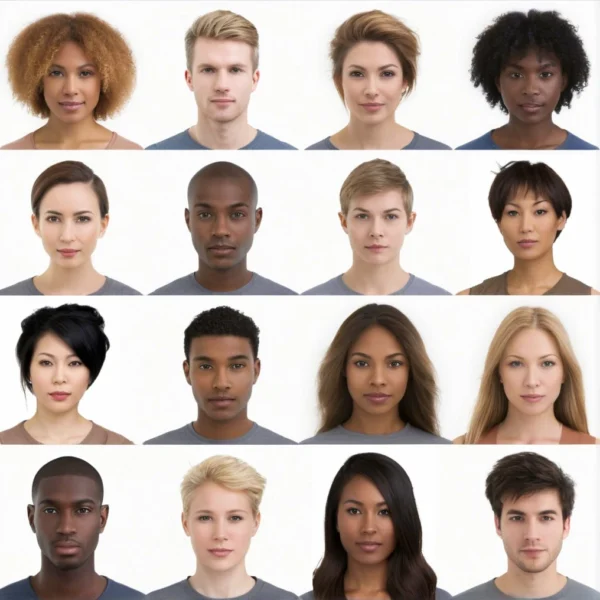The features of human hair extend far beyond its visible characteristics, delving into the realm of genetics and microscopic structures that make each person’s hair uniquely their own. This uniqueness is so profound that even identical twins, even though they share the same DNA, do not have identical hair patterns. This article explores the scientific underpinnings of hair structure variation, providing insight into why even genetically identical individuals have distinct hair characteristics.
Fingerprints are Unique even for Identical Twins: the fingerprints of identical twins are not the same. Even though identical twins share the same genetic makeup, fingerprints are influenced by both genetic and environmental factors present in the womb. The patterns on one’s fingertips are formed by the 13th to 19th week of fetal development and are affected by factors such as the growth rate of the fingers, the position of the fetus in the womb, and the density of the amniotic fluid. These conditions vary for each fetus, leading to unique fingerprints for every individual, including identical twins.
Genetic Blueprint of Hair: Hair is primarily composed of keratins, proteins that also form the basis of nails and the outer layer of skin. Hair and nails are made from hard keratins, while skin epithelium contains soft keratins. The shape, color, and texture of an individual’s hair are determined by their genetic makeup, which dictates the physical characteristics of the hair follicles and the type of keratins that are produced. Although identical twins inherit the same genes from their parents, subtle differences in gene expression can lead to variations in hair structure and hair growth patterns.
The Role of Epigenetics: Epigenetics plays a pivotal role in how genes are expressed without altering the DNA sequence itself. Environmental factors, lifestyle choices, and even aging can cause epigenetic modifications that influence gene expression. In the context of identical twins, these modifications can occur differently for each twin, leading to disparities in hair texture, growth patterns, and even how hair responds to environmental factors. This epigenetic variation is one of the primary reasons why identical twins can have different hair characteristics despite their shared genetic code.
Hair Follicle Shape and Hair Texture: The shape of the hair follicle has a significant impact on hair texture. Straight follicles that are round in cross section tend to produce straight hair, while oval and irregularly shaped follicles create wavy and curly hair, respectively. The distribution and shape of these follicles are genetically determined, yet the degree of similarity between identical twins can vary due to subtle differences in physical structure such as follicle size, density, and orientation, all of which contribute to the unique hair patterns observed in each individual.
Melanin Distribution and Hair Color: Hair color is determined by the type and distribution of melanin within the hair shaft. There are two main types of melanin: eumelanin, which gives hair a black or brown color, and pheomelanin, which provides red or yellow hues. The specific combination and concentration of these melanins are influenced by genetics. However, the exact distribution of melanin can differ among individuals, including identical twins, due to slight variations in melanin production and the number and distribution of melanocytes (melanin-producing cells) in the hair follicles.
Hair Growth Cycle Variation: The hair growth cycle consists of three phases: anagen (growth phase), catagen (transitional phase), and telogen (resting phase). The duration of these phases is genetically determined but can be influenced by environmental factors such as nutrition, health, and stress levels. Habits like smoking and alcohol intake can also have a cumulative impact on hair growth. Identical twins may experience different hair growth rates and shedding patterns due to variations in their hair growth cycles, influenced by their unique environments and life experiences.
Environmental and Lifestyle Factors: External factors, including diet, climate, exposure to chemicals, and hair care practices, can affect hair structure and health. Identical twins living in different environments or adopting different lifestyles may exhibit variations in hair texture, strength, and overall condition. Even differences in hair loss patterns can potentially be used to distinguish between identical twins. These differences highlight the impact of non-genetic factors on hair characteristics, further emphasizing the uniqueness of each individual’s hair.
Scientific Studies and Observations: Research into the genetic and epigenetic factors influencing hair characteristics has revealed a complex interplay between inherited traits and environmental influences. Studies involving identical twins have shown that while they share many physical similarities, there are often noticeable differences in their hair, supporting the idea that hair structure is unique to each individual. Advanced techniques such as genetic sequencing and epigenetic analysis have provided insights into the specific genes and molecular mechanisms that contribute to these differences. However, observation of the hair itself has become a significant method by which to distinguish between different people – even identical twins.
Application in Forensic Science: The uniqueness of hair structure serves as a critical tool in the realm of forensic science. Hair analysis can provide valuable evidence in criminal investigations, helping to link individuals to crime scenes or to exclude them from suspicion. Forensic experts often begin with a microscopic examination of hair found at crime scenes. This analysis can reveal numerous characteristics, such as the hair’s color, length, and diameter, as well as the presence of any artificial treatments (like dyeing or chemical straightening). More importantly, the microscopic structure – such as the pattern of the medulla (the central core of the hair), the cuticle scale pattern, and the overall shape of the hair shaft – can provide clues about an individual’s racial or ethnic background, and sometimes their age and sex.
Mitochondrial DNA Analysis: T he hair shaft itself contains mitochondrial DNA (mtDNA), which can be extracted and analyzed. Mitochondrial DNA is passed from mother to offspring, making it a useful tool for establishing a maternal lineage. In forensic cases, mtDNA analysis can help link a hair sample to individuals within a maternal line, though it’s less specific than nuclear DNA analysis and cannot distinguish between identical twins. However, by combining mtNDA analysis with microscopic examination of the hair fiber itself, evidence is collected that can be presented in court cases to identify specific individuals.
Advancements in Hair Forensics: Recent advancements in technology and methodology have enhanced the reliability and scope of hair analysis in forensic science. Techniques such as secondary ion mass spectrometry (SIMS) and synchrotron radiation-based X-ray fluorescence (XRF) analysis allow for the detailed examination of hair samples at the molecular level, providing insights into the geographical and dietary history of individuals. Forensic scientists can look at the content of hair fibers for amounts of metals and toxins. These techniques open new avenues for the use of hair in forensic investigations, further capitalizing on the unique characteristics of hair structure. While DNA might be the same for identical twins, where they live and what they eat affects the metal and toxin content in their hair.
Limitations and Challenges: Despite its utility, forensic hair analysis is not without its challenges. Environmental exposure, degradation, and the presence of cosmetic treatments can alter the physical and chemical properties of hair, complicating analysis. Additionally, the interpretation of hair evidence requires a high degree of expertise and experience, as well as caution to avoid overestimation of its evidentiary value. Even with these issues in mind, it is clear that forensic study of hair can identify unique characteristics. By leveraging the distinct features of hair structure, along with advanced genetic and molecular analysis techniques, forensic scientists can extract a wealth of information from a single hair sample. This application underscores the importance of hair as not only a subject of biological and genetic interest but also as a key tool in the pursuit of justice.
Conclusion: The claim that “Every person’s hair structure is unique, and even identical twins do not have identical hair patterns” is supported by a wealth of scientific evidence particularly from the world of forensic science. The combination of genetic, epigenetic, and environmental factors creates a complex mosaic of influences that shape the characteristics of an individual’s hair. These findings underscore the remarkable diversity of human hair, highlighting the fact that even the most closely related individuals possess distinct biological and physical traits. As research in genetics and epigenetics advances, our understanding of the factors contributing to the uniqueness of hair structure will continue to deepen, further illuminating the mysteries of human biology.
Bibliography
11711645 {11711645:9BU7D44B},{11711645:5SZAFAQV},{11711645:WQFA5M9T},{11711645:V46H8VVS},{11711645:PTC2SEDZ},{11711645:KRH5RW6N},{11711645:ST3E3W3A},{11711645:WJS839UV},{11711645:9BTB6JIA},{11711645:TTZ8PWJJ},{11711645:VZMR5PDK} 1 vancouver 50 date asc 1138 https://www.keratin.com/wp-content/plugins/zotpress/ %7B%22status%22%3A%22success%22%2C%22updateneeded%22%3Afalse%2C%22instance%22%3Afalse%2C%22meta%22%3A%7B%22request_last%22%3A0%2C%22request_next%22%3A0%2C%22used_cache%22%3Atrue%7D%2C%22data%22%3A%5B%7B%22key%22%3A%22WJS839UV%22%2C%22library%22%3A%7B%22id%22%3A11711645%7D%2C%22meta%22%3A%7B%22creatorSummary%22%3A%22Moeller%20et%20al.%22%2C%22parsedDate%22%3A%221993-12-01%22%2C%22numChildren%22%3A0%7D%2C%22bib%22%3A%22%3Cdiv%20class%3D%5C%22csl-bib-body%5C%22%20style%3D%5C%22line-height%3A%201.35%3B%20%5C%22%3E%5Cn%20%20%3Cdiv%20class%3D%5C%22csl-entry%5C%22%20style%3D%5C%22clear%3A%20left%3B%20%5C%22%3E%5Cn%20%20%20%20%3Cdiv%20class%3D%5C%22csl-left-margin%5C%22%20style%3D%5C%22float%3A%20left%3B%20padding-right%3A%200.5em%3B%20text-align%3A%20right%3B%20width%3A%201em%3B%5C%22%3E1.%3C%5C%2Fdiv%3E%3Cdiv%20class%3D%5C%22csl-right-inline%5C%22%20style%3D%5C%22margin%3A%200%20.4em%200%201.5em%3B%5C%22%3EMoeller%20MR%2C%20Fey%20P%2C%20Sachs%20H.%20Hair%20analysis%20as%20evidence%20in%20forensic%20cases.%20Forensic%20Science%20International.%201993%20Dec%201%3B63%281%29%3A43%26%23x2013%3B53.%3C%5C%2Fdiv%3E%5Cn%20%20%20%3C%5C%2Fdiv%3E%5Cn%3C%5C%2Fdiv%3E%22%2C%22data%22%3A%7B%22itemType%22%3A%22journalArticle%22%2C%22title%22%3A%22Hair%20analysis%20as%20evidence%20in%20forensic%20cases%22%2C%22creators%22%3A%5B%7B%22creatorType%22%3A%22author%22%2C%22firstName%22%3A%22M.%20R%22%2C%22lastName%22%3A%22Moeller%22%7D%2C%7B%22creatorType%22%3A%22author%22%2C%22firstName%22%3A%22P%22%2C%22lastName%22%3A%22Fey%22%7D%2C%7B%22creatorType%22%3A%22author%22%2C%22firstName%22%3A%22H%22%2C%22lastName%22%3A%22Sachs%22%7D%5D%2C%22abstractNote%22%3A%22Because%20hair%20analysis%20can%20be%20used%20for%20the%20determination%20of%20drug%20use%20months%20after%20drug%20consumption%2C%20hair%20analysis%20data%20can%20often%20act%20as%20important%20and%20even%20decisive%20evidence%20in%20the%20courtroom.%20More%20recently%20developed%20GCMS%20methods%20offer%20excellent%20sensitivity%20and%20can%20make%20the%20distinction%20between%20chronic%20heroin%20and%20codeine%20use%2C%20which%20was%20not%20possible%20earlier%20with%20radioimmunoassay%20techniques.%20From%20more%20than%20a%20thousand%20hair%20analyses%2C%20the%20morphine%5C%2Fcodeine%20ratios%20necessary%20to%20determine%20heroin%20use%20were%20set%20at%205%3A1%20for%20low%20morphine%20concentrations%20%28%3C1%20ng%5C%2Fmg%20hair%29%20and%202%3A1%20for%20concentrations%20above%201%20ng%5C%2Fmg%20hair.%20The%20distinction%20can%20be%20further%20focused%20with%20the%20additional%20analysis%20of%20the%20metabolite%20monoacetylmorphine%20%28MAM%29.%20As%20can%20be%20seen%20from%20several%20case%20examples%2C%20hair%20analysis%20cannot%20pinpoint%20an%20exact%20date%20of%20opiate%20use%2C%20but%20it%20can%20be%20used%20to%20validate%20or%20invalidate%20a%20subject%27s%20statement%20concerning%20his%5C%2Fher%20drug%20consumption.%20Interpretations%20should%20always%20be%20made%20cautiously.%20Ranges%2C%20means%20and%20medians%20are%20also%20listed%20for%20amphetamine%2C%20cocaine%20and%20cannabis%20and%20work%20is%20under%20way%20to%20draw%20similar%20safety%20guidelines%20for%20these%20drugs.%22%2C%22date%22%3A%221993-12-01%22%2C%22language%22%3A%22%22%2C%22DOI%22%3A%2210.1016%5C%2F0379-0738%2893%2990258-C%22%2C%22ISSN%22%3A%220379-0738%22%2C%22url%22%3A%22%22%2C%22collections%22%3A%5B%22SUX6VWZ6%22%5D%2C%22dateModified%22%3A%222024-02-01T21%3A04%3A56Z%22%7D%7D%2C%7B%22key%22%3A%229BU7D44B%22%2C%22library%22%3A%7B%22id%22%3A11711645%7D%2C%22meta%22%3A%7B%22creatorSummary%22%3A%22Benner%20Jr%20and%20Levin%22%2C%22parsedDate%22%3A%222007-10-31%22%2C%22numChildren%22%3A0%7D%2C%22bib%22%3A%22%3Cdiv%20class%3D%5C%22csl-bib-body%5C%22%20style%3D%5C%22line-height%3A%201.35%3B%20%5C%22%3E%5Cn%20%20%3Cdiv%20class%3D%5C%22csl-entry%5C%22%20style%3D%5C%22clear%3A%20left%3B%20%5C%22%3E%5Cn%20%20%20%20%3Cdiv%20class%3D%5C%22csl-left-margin%5C%22%20style%3D%5C%22float%3A%20left%3B%20padding-right%3A%200.5em%3B%20text-align%3A%20right%3B%20width%3A%201em%3B%5C%22%3E1.%3C%5C%2Fdiv%3E%3Cdiv%20class%3D%5C%22csl-right-inline%5C%22%20style%3D%5C%22margin%3A%200%20.4em%200%201.5em%3B%5C%22%3EBenner%20Jr%20BA%2C%20Levin%20BC.%20Hair%20and%20human%20identification.%20In%3A%20Tobin%20DJ%2C%20editor.%20Hair%20in%20Toxicology%3A%20An%20Important%20Bio-Monitor.%20Royal%20Society%20of%20Chemistry%3B%202007.%20p.%20104%26%23x2013%3B24.%3C%5C%2Fdiv%3E%5Cn%20%20%20%3C%5C%2Fdiv%3E%5Cn%3C%5C%2Fdiv%3E%22%2C%22data%22%3A%7B%22itemType%22%3A%22bookSection%22%2C%22title%22%3A%22Hair%20and%20human%20identification%22%2C%22creators%22%3A%5B%7B%22creatorType%22%3A%22editor%22%2C%22firstName%22%3A%22Desmond%20John%22%2C%22lastName%22%3A%22Tobin%22%7D%2C%7B%22creatorType%22%3A%22author%22%2C%22firstName%22%3A%22Bruce%20A%22%2C%22lastName%22%3A%22Benner%20Jr%22%7D%2C%7B%22creatorType%22%3A%22author%22%2C%22firstName%22%3A%22Barbara%20C%22%2C%22lastName%22%3A%22Levin%22%7D%5D%2C%22abstractNote%22%3A%22Hair%20in%20Toxicology%3A%20An%20Important%20Biomonitor%20is%20the%20first%20book%20of%20its%20kind%20devoted%20exclusively%20to%20in-depth%20analysis%20of%20the%20hair%20shaft%20as%20an%20important%20tool%20for%20a%20diverse%20range%20of%20scientific%20investigations.%20This%20authoritative%20book%20combines%20contributions%20from%20experts%20in%20academic%2C%20governmental%20and%20industrial%20environments%2C%20to%20provide%20a%20unique%2C%20comprehensive%20look%20at%3A%20-%20Why%20hair%20can%20serve%20as%20an%20invaluable%20bio-resource%20in%20toxicology%2C%20with%20up-to-date%20reviews%20on%20hair%20growth%2C%20hair%20fibre%20formation%20and%20hair%20pigmentation%20-%20Information%20%28including%20regulatory%20details%29%20on%20the%20exposure%20of%20hair%20%28and%20by%20extension%20the%20body%29%20to%20drug%20and%20non-drug%20chemicals%20and%20pollutants%20-%20Toxicological%20issues%20relevant%20to%20the%20use%20of%20hair%20products%20%28including%20colourants%2C%20shampoos%20and%20depilatories%29%20-%20The%20ability%20of%20hair%20to%20capture%20information%20on%20personal%20identity%2C%20chemical%20exposure%2C%20and%20environmental%20interactions%20-%20How%20hair%20can%20provide%20an%20understanding%20of%20human%20life%20from%20archaeological%20and%20historical%20perspectives%20-%20Future%20direction%20in%20the%20use%20of%20hair%20in%20toxicology%20Hair%20in%20Toxicology%3A%20An%20Important%20Biomonitor%20is%20ideal%20as%20a%20reference%20and%20guide%20to%20investigations%20in%20the%20biomedical%2C%20biochemical%20and%20pharmaceutical%20sciences%20at%20the%20graduate%20and%20post%20graduate%20level.%22%2C%22bookTitle%22%3A%22Hair%20in%20Toxicology%3A%20An%20Important%20Bio-Monitor%22%2C%22date%22%3A%222007-10-31%22%2C%22language%22%3A%22en%22%2C%22ISBN%22%3A%229781847552518%22%2C%22url%22%3A%22%22%2C%22collections%22%3A%5B%22SUX6VWZ6%22%5D%2C%22dateModified%22%3A%222024-02-01T20%3A35%3A58Z%22%7D%7D%2C%7B%22key%22%3A%22V46H8VVS%22%2C%22library%22%3A%7B%22id%22%3A11711645%7D%2C%22meta%22%3A%7B%22creatorSummary%22%3A%22Su%20and%20Kong%22%2C%22parsedDate%22%3A%222014-04%22%2C%22numChildren%22%3A0%7D%2C%22bib%22%3A%22%3Cdiv%20class%3D%5C%22csl-bib-body%5C%22%20style%3D%5C%22line-height%3A%201.35%3B%20%5C%22%3E%5Cn%20%20%3Cdiv%20class%3D%5C%22csl-entry%5C%22%20style%3D%5C%22clear%3A%20left%3B%20%5C%22%3E%5Cn%20%20%20%20%3Cdiv%20class%3D%5C%22csl-left-margin%5C%22%20style%3D%5C%22float%3A%20left%3B%20padding-right%3A%200.5em%3B%20text-align%3A%20right%3B%20width%3A%201em%3B%5C%22%3E1.%3C%5C%2Fdiv%3E%3Cdiv%20class%3D%5C%22csl-right-inline%5C%22%20style%3D%5C%22margin%3A%200%20.4em%200%201.5em%3B%5C%22%3ESu%20H%2C%20Kong%20AWK.%20A%20Study%20on%20Low%20Resolution%20Androgenic%20Hair%20Patterns%20for%20Criminal%20and%20Victim%20Identification.%20IEEE%20Transactions%20on%20Information%20Forensics%20and%20Security.%202014%20Apr%3B9%284%29%3A666%26%23x2013%3B80.%3C%5C%2Fdiv%3E%5Cn%20%20%20%3C%5C%2Fdiv%3E%5Cn%3C%5C%2Fdiv%3E%22%2C%22data%22%3A%7B%22itemType%22%3A%22journalArticle%22%2C%22title%22%3A%22A%20Study%20on%20Low%20Resolution%20Androgenic%20Hair%20Patterns%20for%20Criminal%20and%20Victim%20Identification%22%2C%22creators%22%3A%5B%7B%22creatorType%22%3A%22author%22%2C%22firstName%22%3A%22Han%22%2C%22lastName%22%3A%22Su%22%7D%2C%7B%22creatorType%22%3A%22author%22%2C%22firstName%22%3A%22Adams%20Wai%20Kin%22%2C%22lastName%22%3A%22Kong%22%7D%5D%2C%22abstractNote%22%3A%22Identifying%20criminals%20and%20victims%20in%20images%20%28e.g.%2C%20child%20pornography%20and%20masked%20gunmen%29%20can%20be%20a%20challenging%20task%2C%20especially%20when%20neither%20their%20faces%20nor%20tattoos%20are%20observable.%20Skin%20mark%20patterns%20and%20blood%20vessel%20patterns%20are%20recently%20proposed%20to%20address%20this%20problem.%20However%2C%20they%20are%20invisible%20in%20low-resolution%20images%20and%20dense%20androgenic%20hair%20can%20cover%20them%20completely.%20Medical%20research%20results%20have%20implied%20that%20androgenic%20hair%20patterns%20are%20a%20stable%20biometric%20trait%20and%20have%20potential%20to%20overcome%20the%20weaknesses%20of%20skin%20mark%20patterns%20and%20blood%20vessel%20patterns.%20To%20the%20best%20of%20our%20knowledge%2C%20no%20one%20has%20studied%20androgenic%20hair%20patterns%20for%20criminal%20and%20victim%20identification%20before.%20This%20paper%20aims%20to%20study%20matching%20performance%20of%20androgenic%20hair%20patterns%20in%20low-resolution%20images.%20An%20algorithm%20designed%20for%20this%20paper%20uses%20Gabor%20filters%20to%20compute%20orientation%20fields%20of%20androgenic%20hair%20patterns%2C%20histograms%20on%20a%20dynamic%20grid%20system%20to%20describe%20their%20local%20orientation%20fields%2C%20and%20the%20blockwise%20Chi-square%20distance%20to%20measure%20the%20dissimilarity%20between%20two%20patterns.%20The%204552%20images%20from%20283%20different%20legs%20with%20resolutions%20of%2025%2C%2018.75%2C%2012.5%2C%20and%206.25%20dpi%20were%20examined.%20The%20experimental%20results%20indicate%20that%20androgenic%20hair%20patterns%20even%20in%20low-resolution%20images%20are%20an%20effective%20biometric%20trait%20and%20the%20proposed%20Gabor%20orientation%20histograms%20are%20comparable%20with%20other%20well-known%20texture%20recognition%20methods%2C%20including%20local%20binary%20patterns%2C%20local%20Gabor%20binary%20patterns%2C%20and%20histograms%20of%20oriented%20gradients.%22%2C%22date%22%3A%222014-04%22%2C%22language%22%3A%22%22%2C%22DOI%22%3A%2210.1109%5C%2FTIFS.2014.2306591%22%2C%22ISSN%22%3A%221556-6021%22%2C%22url%22%3A%22%22%2C%22collections%22%3A%5B%22SUX6VWZ6%22%5D%2C%22dateModified%22%3A%222024-02-01T20%3A37%3A10Z%22%7D%7D%2C%7B%22key%22%3A%22KRH5RW6N%22%2C%22library%22%3A%7B%22id%22%3A11711645%7D%2C%22meta%22%3A%7B%22creatorSummary%22%3A%22Manheim%20et%20al.%22%2C%22parsedDate%22%3A%222016%22%2C%22numChildren%22%3A0%7D%2C%22bib%22%3A%22%3Cdiv%20class%3D%5C%22csl-bib-body%5C%22%20style%3D%5C%22line-height%3A%201.35%3B%20%5C%22%3E%5Cn%20%20%3Cdiv%20class%3D%5C%22csl-entry%5C%22%20style%3D%5C%22clear%3A%20left%3B%20%5C%22%3E%5Cn%20%20%20%20%3Cdiv%20class%3D%5C%22csl-left-margin%5C%22%20style%3D%5C%22float%3A%20left%3B%20padding-right%3A%200.5em%3B%20text-align%3A%20right%3B%20width%3A%201em%3B%5C%22%3E1.%3C%5C%2Fdiv%3E%3Cdiv%20class%3D%5C%22csl-right-inline%5C%22%20style%3D%5C%22margin%3A%200%20.4em%200%201.5em%3B%5C%22%3EManheim%20J%2C%20Doty%20KC%2C%20McLaughlin%20G%2C%20Lednev%20IK.%20Forensic%20Hair%20Differentiation%20Using%20Attenuated%20Total%20Reflection%20Fourier%20Transform%20Infrared%20%28ATR%20FT-IR%29%20Spectroscopy.%20Appl%20Spectrosc.%202016%3B70%287%29%3A1109%26%23x2013%3B17.%3C%5C%2Fdiv%3E%5Cn%20%20%20%3C%5C%2Fdiv%3E%5Cn%3C%5C%2Fdiv%3E%22%2C%22data%22%3A%7B%22itemType%22%3A%22journalArticle%22%2C%22title%22%3A%22Forensic%20Hair%20Differentiation%20Using%20Attenuated%20Total%20Reflection%20Fourier%20Transform%20Infrared%20%28ATR%20FT-IR%29%20Spectroscopy%22%2C%22creators%22%3A%5B%7B%22creatorType%22%3A%22author%22%2C%22firstName%22%3A%22Jeremy%22%2C%22lastName%22%3A%22Manheim%22%7D%2C%7B%22creatorType%22%3A%22author%22%2C%22firstName%22%3A%22Kyle%20C.%22%2C%22lastName%22%3A%22Doty%22%7D%2C%7B%22creatorType%22%3A%22author%22%2C%22firstName%22%3A%22Gregory%22%2C%22lastName%22%3A%22McLaughlin%22%7D%2C%7B%22creatorType%22%3A%22author%22%2C%22firstName%22%3A%22Igor%20K.%22%2C%22lastName%22%3A%22Lednev%22%7D%5D%2C%22abstractNote%22%3A%22Hair%20and%20fibers%20are%20common%20forms%20of%20trace%20evidence%20found%20at%20crime%20scenes.%20The%20current%20methodology%20of%20microscopic%20examination%20of%20potential%20hair%20evidence%20is%20absent%20of%20statistical%20measures%20of%20performance%2C%20and%20examiner%20results%20for%20identification%20can%20be%20subjective.%20Here%2C%20attenuated%20total%20reflection%20%28ATR%29%20Fourier%20transform-infrared%20%28FT-IR%29%20spectroscopy%20was%20used%20to%20analyze%20synthetic%20fibers%20and%20natural%20hairs%20of%20human%2C%20cat%2C%20and%20dog%20origin.%20Chemometric%20analysis%20was%20used%20to%20differentiate%20hair%20spectra%20from%20the%20three%20different%20species%2C%20and%20to%20predict%20unknown%20hairs%20to%20their%20proper%20species%20class%2C%20with%20a%20high%20degree%20of%20certainty.%20A%20species-specific%20partial%20least%20squares%20discriminant%20analysis%20%28PLSDA%29%20model%20was%20constructed%20to%20discriminate%20human%20hair%20from%20cat%20and%20dog%20hairs.%20This%20model%20was%20successful%20in%20distinguishing%20between%20the%20three%20classes%20and%2C%20more%20importantly%2C%20all%20human%20samples%20were%20correctly%20predicted%20as%20human.%20An%20external%20validation%20resulted%20in%20zero%20false%20positive%20and%20false%20negative%20assignments%20for%20the%20human%20class.%20From%20a%20forensic%20perspective%2C%20this%20technique%20would%20be%20complementary%20to%20microscopic%20hair%20examination%2C%20and%20in%20no%20way%20replace%20it.%20As%20such%2C%20this%20methodology%20is%20able%20to%20provide%20a%20statistical%20measure%20of%20confidence%20to%20the%20identification%20of%20a%20sample%20of%20human%2C%20cat%2C%20and%20dog%20hair%2C%20which%20was%20called%20for%20in%20the%202009%20National%20Academy%20of%20Sciences%20report.%20More%20importantly%2C%20this%20approach%20is%20non-destructive%2C%20rapid%2C%20can%20provide%20reliable%20results%2C%20and%20requires%20no%20sample%20preparation%2C%20making%20it%20of%20ample%20importance%20to%20the%20field%20of%20forensic%20science.%22%2C%22date%22%3A%2207%5C%2F2016%22%2C%22language%22%3A%22en%22%2C%22DOI%22%3A%2210.1177%5C%2F0003702816652321%22%2C%22ISSN%22%3A%220003-7028%2C%201943-3530%22%2C%22url%22%3A%22%22%2C%22collections%22%3A%5B%22SUX6VWZ6%22%5D%2C%22dateModified%22%3A%222024-02-01T20%3A46%3A30Z%22%7D%7D%2C%7B%22key%22%3A%22WQFA5M9T%22%2C%22library%22%3A%7B%22id%22%3A11711645%7D%2C%22meta%22%3A%7B%22creatorSummary%22%3A%22Chan%20and%20Kong%22%2C%22parsedDate%22%3A%222018-01-01%22%2C%22numChildren%22%3A0%7D%2C%22bib%22%3A%22%3Cdiv%20class%3D%5C%22csl-bib-body%5C%22%20style%3D%5C%22line-height%3A%201.35%3B%20%5C%22%3E%5Cn%20%20%3Cdiv%20class%3D%5C%22csl-entry%5C%22%20style%3D%5C%22clear%3A%20left%3B%20%5C%22%3E%5Cn%20%20%20%20%3Cdiv%20class%3D%5C%22csl-left-margin%5C%22%20style%3D%5C%22float%3A%20left%3B%20padding-right%3A%200.5em%3B%20text-align%3A%20right%3B%20width%3A%201em%3B%5C%22%3E1.%3C%5C%2Fdiv%3E%3Cdiv%20class%3D%5C%22csl-right-inline%5C%22%20style%3D%5C%22margin%3A%200%20.4em%200%201.5em%3B%5C%22%3EChan%20FKS%2C%20Kong%20AWK.%20A%20further%20study%20of%20low%20resolution%20androgenic%20hair%20patterns%20as%20a%20soft%20biometric%20trait.%20Image%20and%20Vision%20Computing.%202018%20Jan%201%3B69%3A125%26%23x2013%3B42.%3C%5C%2Fdiv%3E%5Cn%20%20%20%3C%5C%2Fdiv%3E%5Cn%3C%5C%2Fdiv%3E%22%2C%22data%22%3A%7B%22itemType%22%3A%22journalArticle%22%2C%22title%22%3A%22A%20further%20study%20of%20low%20resolution%20androgenic%20hair%20patterns%20as%20a%20soft%20biometric%20trait%22%2C%22creators%22%3A%5B%7B%22creatorType%22%3A%22author%22%2C%22firstName%22%3A%22Frodo%20Kin%20Sun%22%2C%22lastName%22%3A%22Chan%22%7D%2C%7B%22creatorType%22%3A%22author%22%2C%22firstName%22%3A%22Adams%20Wai%20Kin%22%2C%22lastName%22%3A%22Kong%22%7D%5D%2C%22abstractNote%22%3A%22Soft%20biometric%20traits%20such%20as%20skin%20color%2C%20tattoos%2C%20shoe%20size%2C%20height%2C%20and%20weight%20have%20been%20regularly%20used%20for%20forensic%20investigation%2C%20especially%20when%20hard%20biometric%20traits%2C%20e.g.%2C%20faces%20and%20fingerprints%20are%20not%20available.%20Recently%2C%20a%20new%20soft%20biometric%20trait%2C%20androgenic%20hair%20also%20called%20body%20hair%2C%20was%20evaluated.%20The%20previous%20study%20showed%20that%20low%20resolution%20androgenic%20hair%20patterns%20have%20potential%20for%20forensic%20investigation.%20However%2C%20it%20was%20believed%20that%20they%20are%20not%20a%20distinctive%20biometric%20trait%20because%20of%20the%20reported%20accuracy.%20To%20explore%20discriminative%20information%20in%20androgenic%20hair%20patterns%2C%20in%20this%20paper%2C%20a%20new%20algorithm%2C%20which%20makes%20use%20of%20leg%20geometry%20to%20align%20lower%20leg%20images%2C%20large%20feature%20sets%20%28about%2060%2C000%20features%29%20extracted%20through%20multi-directional%20grid%20systems%20to%20increase%20discriminative%20power%20and%20robustness%2C%20and%20class-specific%20partial%20least%20squares%20%28PLS%29%20models%20to%20utilize%20the%20features%20effectively%2C%20is%20employed.%20To%20further%20enhance%20the%20performance%20of%20the%20class-specific%20PLS%20models%20trained%20on%20very%20limited%20positive%20samples%2C%20one%20to%20three%20images%20per%20model%20in%20the%20experiments%2C%20and%20further%20enhance%20robustness%20against%20viewpoint%20and%20pose%20variations%2C%20a%20scheme%20is%20designed%20to%20generate%20more%20positive%20samples%20from%20a%20single%20image.%20Experimental%20results%20on%201493%20low%20resolution%20leg%20images%20with%20large%20viewpoint%20and%20pose%20variations%20from%20412%20legs%20demonstrate%20that%20low%20resolution%20androgenic%20hair%20patterns%20contain%20rich%20information%20and%20the%20impression%20of%20low%20discriminative%20power%20on%20androgenic%20hair%20is%20due%20to%20the%20method%20used%20in%20the%20previous%20study.%22%2C%22date%22%3A%222018-01-01%22%2C%22language%22%3A%22%22%2C%22DOI%22%3A%2210.1016%5C%2Fj.imavis.2017.08.009%22%2C%22ISSN%22%3A%220262-8856%22%2C%22url%22%3A%22%22%2C%22collections%22%3A%5B%22SUX6VWZ6%22%5D%2C%22dateModified%22%3A%222024-02-01T21%3A04%3A41Z%22%7D%7D%2C%7B%22key%22%3A%22ST3E3W3A%22%2C%22library%22%3A%7B%22id%22%3A11711645%7D%2C%22meta%22%3A%7B%22creatorSummary%22%3A%22Mason%20et%20al.%22%2C%22parsedDate%22%3A%222019%22%2C%22numChildren%22%3A0%7D%2C%22bib%22%3A%22%3Cdiv%20class%3D%5C%22csl-bib-body%5C%22%20style%3D%5C%22line-height%3A%201.35%3B%20%5C%22%3E%5Cn%20%20%3Cdiv%20class%3D%5C%22csl-entry%5C%22%20style%3D%5C%22clear%3A%20left%3B%20%5C%22%3E%5Cn%20%20%20%20%3Cdiv%20class%3D%5C%22csl-left-margin%5C%22%20style%3D%5C%22float%3A%20left%3B%20padding-right%3A%200.5em%3B%20text-align%3A%20right%3B%20width%3A%201em%3B%5C%22%3E1.%3C%5C%2Fdiv%3E%3Cdiv%20class%3D%5C%22csl-right-inline%5C%22%20style%3D%5C%22margin%3A%200%20.4em%200%201.5em%3B%5C%22%3EMason%20KE%2C%20Paul%20PH%2C%20Chu%20F%2C%20Anex%20DS%2C%20Hart%20BR.%20Development%20of%20a%20Protein%26%23x2010%3Bbased%20Human%20Identification%20Capability%20from%20a%20Single%20Hair.%20Journal%20of%20Forensic%20Sciences.%202019%3B64%284%29%3A1152%26%23x2013%3B9.%3C%5C%2Fdiv%3E%5Cn%20%20%20%3C%5C%2Fdiv%3E%5Cn%3C%5C%2Fdiv%3E%22%2C%22data%22%3A%7B%22itemType%22%3A%22journalArticle%22%2C%22title%22%3A%22Development%20of%20a%20Protein%5Cu2010based%20Human%20Identification%20Capability%20from%20a%20Single%20Hair%22%2C%22creators%22%3A%5B%7B%22creatorType%22%3A%22author%22%2C%22firstName%22%3A%22Katelyn%20E.%22%2C%22lastName%22%3A%22Mason%22%7D%2C%7B%22creatorType%22%3A%22author%22%2C%22firstName%22%3A%22Phillip%20H.%22%2C%22lastName%22%3A%22Paul%22%7D%2C%7B%22creatorType%22%3A%22author%22%2C%22firstName%22%3A%22Fanny%22%2C%22lastName%22%3A%22Chu%22%7D%2C%7B%22creatorType%22%3A%22author%22%2C%22firstName%22%3A%22Deon%20S.%22%2C%22lastName%22%3A%22Anex%22%7D%2C%7B%22creatorType%22%3A%22author%22%2C%22firstName%22%3A%22Bradley%20R.%22%2C%22lastName%22%3A%22Hart%22%7D%5D%2C%22abstractNote%22%3A%22Abstract%20%5Cn%20%20%20%20%20%20%20%20%20%20%20%20%20%5Cn%20%20%20%20%20%20%20%20%20%20%20%20%20%20Shed%20human%20hair%20%28lacking%20root%20nuclear%20%5Cn%20%20%20%20%20%20%20%20%20%20%20%20%20%20DNA%20%5Cn%20%20%20%20%20%20%20%20%20%20%20%20%20%20%29%20frequently%20contributes%20important%20information%20to%20forensic%20investigations%20involving%20human%20identification.%20Detection%20of%20genetic%20variation%20observed%20in%20amino%20acid%20sequences%20of%20hair%20proteins%20provides%20a%20new%20suite%20of%20identity%20markers%20that%20augment%20microscopic%20hair%20analysis%20and%20mitochondrial%20%5Cn%20%20%20%20%20%20%20%20%20%20%20%20%20%20DNA%20%5Cn%20%20%20%20%20%20%20%20%20%20%20%20%20%20sequencing.%20In%20this%20study%2C%20a%20new%20method%20that%20completely%20dissolves%20single%20hairs%20using%20a%20combination%20of%20heat%2C%20ultrasonication%2C%20and%20surfactants%20was%20developed.%20Dissolved%20proteins%20were%20digested%20and%20genetically%20variant%20peptide%20%28%20%5Cn%20%20%20%20%20%20%20%20%20%20%20%20%20%20GVP%20%5Cn%20%20%20%20%20%20%20%20%20%20%20%20%20%20%29%20profiles%20were%20obtained%20for%20single%20hairs%20%2825%5Cu00a0mm%29%20via%20high%5Cu2010resolution%20nanoflow%20liquid%20chromatography%5Cu2010based%20mass%20spectrometry%20and%20a%20novel%20exome%5Cu2010driven%20bioinformatic%20approach.%20Overall%2C%206519%20unique%20peptides%20were%20identified%20and%20a%20total%20of%2057%20%5Cn%20%20%20%20%20%20%20%20%20%20%20%20%20%20GVP%20%5Cn%20%20%20%20%20%20%20%20%20%20%20%20%20%20s%20were%20confirmed.%20Random%20match%20probabilities%20ranged%20between%202.6%5Cu00a0%5Cu00d7%5Cu00a010%20%5Cn%20%20%20%20%20%20%20%20%20%20%20%20%20%20%5Cu22122%20%5Cn%20%20%20%20%20%20%20%20%20%20%20%20%20%20and%206.0%5Cu00a0%5Cu00d7%5Cu00a010%20%5Cn%20%20%20%20%20%20%20%20%20%20%20%20%20%20%5Cu22129%20%5Cn%20%20%20%20%20%20%20%20%20%20%20%20%20%20.%20The%20new%20bioinformatic%20strategy%20and%20ability%20to%20analyze%20%5Cn%20%20%20%20%20%20%20%20%20%20%20%20%20%20GVP%20%5Cn%20%20%20%20%20%20%20%20%20%20%20%20%20%20s%20in%20forensically%20relevant%20samples%20sizes%20demonstrate%20applicability%20of%20this%20approach%20to%20distinguish%20individuals%20in%20forensic%20contexts.%22%2C%22date%22%3A%2207%5C%2F2019%22%2C%22language%22%3A%22en%22%2C%22DOI%22%3A%2210.1111%5C%2F1556-4029.13995%22%2C%22ISSN%22%3A%220022-1198%2C%201556-4029%22%2C%22url%22%3A%22%22%2C%22collections%22%3A%5B%22SUX6VWZ6%22%5D%2C%22dateModified%22%3A%222024-02-01T21%3A04%3A48Z%22%7D%7D%2C%7B%22key%22%3A%225SZAFAQV%22%2C%22library%22%3A%7B%22id%22%3A11711645%7D%2C%22meta%22%3A%7B%22creatorSummary%22%3A%22Bisbing%22%2C%22parsedDate%22%3A%222020%22%2C%22numChildren%22%3A0%7D%2C%22bib%22%3A%22%3Cdiv%20class%3D%5C%22csl-bib-body%5C%22%20style%3D%5C%22line-height%3A%201.35%3B%20%5C%22%3E%5Cn%20%20%3Cdiv%20class%3D%5C%22csl-entry%5C%22%20style%3D%5C%22clear%3A%20left%3B%20%5C%22%3E%5Cn%20%20%20%20%3Cdiv%20class%3D%5C%22csl-left-margin%5C%22%20style%3D%5C%22float%3A%20left%3B%20padding-right%3A%200.5em%3B%20text-align%3A%20right%3B%20width%3A%201em%3B%5C%22%3E1.%3C%5C%2Fdiv%3E%3Cdiv%20class%3D%5C%22csl-right-inline%5C%22%20style%3D%5C%22margin%3A%200%20.4em%200%201.5em%3B%5C%22%3EBisbing%20RE.%20The%20Forensic%20Identification%20and%20Association%20of%20Human%20Hair.%20In%3A%20Hall%20AB%2C%20Saferstein%20R%2C%20editors.%20Forensic%20Science%20Handbook%2C%20Volume%20I.%203rd%20ed.%20CRC%20Press%3B%202020.%20p.%20151%26%23x2013%3B200.%3C%5C%2Fdiv%3E%5Cn%20%20%20%3C%5C%2Fdiv%3E%5Cn%3C%5C%2Fdiv%3E%22%2C%22data%22%3A%7B%22itemType%22%3A%22bookSection%22%2C%22title%22%3A%22The%20Forensic%20Identification%20and%20Association%20of%20Human%20Hair%22%2C%22creators%22%3A%5B%7B%22creatorType%22%3A%22author%22%2C%22firstName%22%3A%22Richard%20E.%22%2C%22lastName%22%3A%22Bisbing%22%7D%2C%7B%22creatorType%22%3A%22editor%22%2C%22firstName%22%3A%22Adam%20B%22%2C%22lastName%22%3A%22Hall%22%7D%2C%7B%22creatorType%22%3A%22editor%22%2C%22firstName%22%3A%22Richard%22%2C%22lastName%22%3A%22Saferstein%22%7D%5D%2C%22abstractNote%22%3A%22This%20chapter%20reviews%20pertinent%20concepts%20underlying%20the%20forensic%20examination%20of%20human%20hair%20and%20helps%20the%20reader%20understand%2C%20describe%2C%20and%20interpret%20particular%20data%20with%20respect%20to%20this%20forensic%20science.%20Human%20hair%20is%20particularly%20useful%20associative%20evidence%20because%20it%20originates%20directly%20from%20the%20individual.%20Since%20hair%20continually%20falls%20from%20the%20body%20of%20every%20person%2C%20it%20is%20often%20present%20at%20the%20crime%20scene%20or%20on%20the%20clothing%20of%20the%20participants.%20By%20the%20beginning%20of%20the%20twentieth%20century%2C%20the%20significance%20of%20hair%20in%20criminal%20investigations%20had%20come%20under%20scrutiny%20by%20a%20growing%20number%20of%20medicolegal%20experts.%20Forensic%20scientists%20in%20newly%20opened%20crime%20laboratories%20applied%20microscopy%20to%20the%20identification%20and%20association%20of%20hair%20and%20used%20it%20as%20evidence.%20A%20microscopical%20examination%20of%20a%20hair%20cross%20section%20reveals%20an%20outer%20layer%20of%20cuticular%20scales%20that%20surrounds%20the%20shaft%2C%20an%20inner%20darker%20portion%20called%20the%20cortex%2C%20and%5Cu2014in%20the%20center%20of%20the%20cortex%5Cu2014a%20canal-like%20structure%20called%20the%20medulla.%22%2C%22bookTitle%22%3A%22Forensic%20Science%20Handbook%2C%20Volume%20I%22%2C%22date%22%3A%222020%22%2C%22language%22%3A%22%22%2C%22ISBN%22%3A%229781315119939%22%2C%22url%22%3A%22%22%2C%22collections%22%3A%5B%22SUX6VWZ6%22%5D%2C%22dateModified%22%3A%222024-02-01T20%3A45%3A09Z%22%7D%7D%2C%7B%22key%22%3A%22VZMR5PDK%22%2C%22library%22%3A%7B%22id%22%3A11711645%7D%2C%22meta%22%3A%7B%22creatorSummary%22%3A%22Wilkinson%20and%20Gwinnett%22%2C%22parsedDate%22%3A%222020-03-01%22%2C%22numChildren%22%3A0%7D%2C%22bib%22%3A%22%3Cdiv%20class%3D%5C%22csl-bib-body%5C%22%20style%3D%5C%22line-height%3A%201.35%3B%20%5C%22%3E%5Cn%20%20%3Cdiv%20class%3D%5C%22csl-entry%5C%22%20style%3D%5C%22clear%3A%20left%3B%20%5C%22%3E%5Cn%20%20%20%20%3Cdiv%20class%3D%5C%22csl-left-margin%5C%22%20style%3D%5C%22float%3A%20left%3B%20padding-right%3A%200.5em%3B%20text-align%3A%20right%3B%20width%3A%201em%3B%5C%22%3E1.%3C%5C%2Fdiv%3E%3Cdiv%20class%3D%5C%22csl-right-inline%5C%22%20style%3D%5C%22margin%3A%200%20.4em%200%201.5em%3B%5C%22%3EWilkinson%20L%2C%20Gwinnett%20C.%20An%20international%20survey%20into%20the%20analysis%20and%20interpretation%20of%20microscopic%20hair%20evidence%20by%20forensic%20hair%20examiners.%20Forensic%20Science%20International.%202020%20Mar%201%3B308%3A110158.%3C%5C%2Fdiv%3E%5Cn%20%20%20%3C%5C%2Fdiv%3E%5Cn%3C%5C%2Fdiv%3E%22%2C%22data%22%3A%7B%22itemType%22%3A%22journalArticle%22%2C%22title%22%3A%22An%20international%20survey%20into%20the%20analysis%20and%20interpretation%20of%20microscopic%20hair%20evidence%20by%20forensic%20hair%20examiners%22%2C%22creators%22%3A%5B%7B%22creatorType%22%3A%22author%22%2C%22firstName%22%3A%22Laura%22%2C%22lastName%22%3A%22Wilkinson%22%7D%2C%7B%22creatorType%22%3A%22author%22%2C%22firstName%22%3A%22Claire%22%2C%22lastName%22%3A%22Gwinnett%22%7D%5D%2C%22abstractNote%22%3A%22Due%20to%20inadequacies%20in%20historical%20hair%20examinations%2C%20the%20use%20and%20perceived%20value%20of%20microscopic%20hair%20evidence%20has%20reduced.%20Many%20reports%20have%20heavily%20criticised%20the%20use%20of%20pattern-based%20evidence%20including%20hair%20evidence%20as%20being%20unreliable%2C%20with%20police%20forces%20focussing%20on%20more%20individualising%20evidence.%20Hair%20evidence%20has%20been%20utilised%20in%20casework%20for%20many%20years%20due%20to%20its%20ability%20to%20transfer%20easily%20between%20individuals%20and%20crime%20scenes.%20Hair%20evidence%20can%20provide%20important%20information%20in%20criminal%20investigations%2C%20and%20in%20certain%20circumstances%2C%20aid%20in%20the%20identification%20of%20an%20individual%2C%20along%20with%20providing%20information%20to%20aid%20in%20the%20reconstruction%20of%20a%20crime%20scene.%20It%20has%20become%20apparent%20in%20recent%20studies%2C%20such%20as%20the%202012%20FBI%20review%2C%20that%20hair%20evidence%20has%20been%20inappropriately%20utilised%20in%20case%20work%20and%20this%2C%20along%20with%20a%20preference%20for%20more%20discriminating%20methods%20such%20as%20DNA%20profiling%2C%20has%20led%20to%20both%20a%20lack%20of%20confidence%20in%20and%20reduction%20of%20use%20of%20hair%20evidence.%20The%20need%20for%20more%20standardised%20and%20objective%20methods%20is%20required%20along%20with%20improved%20methods%20for%20interpreting%20hair%20evidence.%20Since%20these%20reports%2C%20there%20has%20been%20no%20study%20investigating%20how%20these%20have%20affected%20the%20perceptions%20of%20hair%20evidence%20by%20forensic%20hair%20examiners%20or%20that%20has%20investigated%20what%20methods%20are%20being%20utilised%20to%20create%20a%20robust%2C%20objective%20and%20reliable%20interpretation%20of%20this%20evidence.%20This%20study%20aimed%20to%20assess%20the%20current%20similarities%20and%20differences%20in%20microscopic%20hair%20examinations%20and%20perceptions%20of%20its%20evidential%20value%20between%20countries%2C%20with%20a%20focus%20on%20the%20analysis%20and%20interpretation%20methods%20used%20by%20case%20work%20examiners%20and%20researchers.%20This%20study%20will%20discuss%20the%20findings%20of%20a%20survey%20and%20interviews%20completed%20by%20hair%20examiners.%20Previous%20surveys%20have%20been%20conducted%20by%20Aitken%20%26%20Robertson%20%281986%29%20and%20Murphy%20%282013%29%2C%20however%20the%20current%20international%20status%20of%20microscopic%20hair%20examinations%20is%20unknown.%20This%20study%20gathered%20responses%20across%209%20countries.%20From%20this%2C%20it%20was%20identified%20that%20the%20microscopic%20examination%20of%20hair%20evidence%20is%20still%20valued%20highly%20by%20those%20practicing%20it.%20The%20amount%20of%20cases%20that%20an%20examiner%20has%20worked%20on%20that%20involve%20the%20examination%20of%20microscopic%20hair%20evidence%20is%20correlated%20to%20the%20perceived%20evidential%20value%20of%20hair%20evidence%20and%20to%20the%20value%20of%20morphological%20characteristics%20of%20hair.%20There%20are%20inconsistencies%20between%20the%20approaches%20used%20in%20interpreting%20this%20type%20of%20evidence.%20Subsequently%2C%20this%20study%20has%20generated%20an%20international%20understanding%20of%20the%20current%20status%20of%20hair%20examinations%20which%20was%20not%20previously%20known%20from%20an%20operational%20perspective.%22%2C%22date%22%3A%222020-03-01%22%2C%22language%22%3A%22%22%2C%22DOI%22%3A%2210.1016%5C%2Fj.forsciint.2020.110158%22%2C%22ISSN%22%3A%220379-0738%22%2C%22url%22%3A%22%22%2C%22collections%22%3A%5B%22SUX6VWZ6%22%5D%2C%22dateModified%22%3A%222024-02-01T20%3A51%3A13Z%22%7D%7D%2C%7B%22key%22%3A%22TTZ8PWJJ%22%2C%22library%22%3A%7B%22id%22%3A11711645%7D%2C%22meta%22%3A%7B%22creatorSummary%22%3A%22Mussabekova%20and%20Mkhitaryan%22%2C%22parsedDate%22%3A%222021-07-01%22%2C%22numChildren%22%3A0%7D%2C%22bib%22%3A%22%3Cdiv%20class%3D%5C%22csl-bib-body%5C%22%20style%3D%5C%22line-height%3A%201.35%3B%20%5C%22%3E%5Cn%20%20%3Cdiv%20class%3D%5C%22csl-entry%5C%22%20style%3D%5C%22clear%3A%20left%3B%20%5C%22%3E%5Cn%20%20%20%20%3Cdiv%20class%3D%5C%22csl-left-margin%5C%22%20style%3D%5C%22float%3A%20left%3B%20padding-right%3A%200.5em%3B%20text-align%3A%20right%3B%20width%3A%201em%3B%5C%22%3E1.%3C%5C%2Fdiv%3E%3Cdiv%20class%3D%5C%22csl-right-inline%5C%22%20style%3D%5C%22margin%3A%200%20.4em%200%201.5em%3B%5C%22%3EMussabekova%20SA%2C%20Mkhitaryan%20XE.%20Elemental%20composition%20of%20hair%20as%20a%20marker%20for%20forensic%20human%20identification.%20Journal%20of%20Forensic%20and%20Legal%20Medicine.%202021%20Jul%201%3B81%3A102182.%3C%5C%2Fdiv%3E%5Cn%20%20%20%3C%5C%2Fdiv%3E%5Cn%3C%5C%2Fdiv%3E%22%2C%22data%22%3A%7B%22itemType%22%3A%22journalArticle%22%2C%22title%22%3A%22Elemental%20composition%20of%20hair%20as%20a%20marker%20for%20forensic%20human%20identification%22%2C%22creators%22%3A%5B%7B%22creatorType%22%3A%22author%22%2C%22firstName%22%3A%22Saule%20A.%22%2C%22lastName%22%3A%22Mussabekova%22%7D%2C%7B%22creatorType%22%3A%22author%22%2C%22firstName%22%3A%22Xeniya%20E.%22%2C%22lastName%22%3A%22Mkhitaryan%22%7D%5D%2C%22abstractNote%22%3A%22Background%5CnHair%20is%20one%20of%20the%20most%20common%20evidence%20types%20found%20in%20criminal%20investigations.%20Analysis%20of%20human%20hair%20reveals%20the%20mineral%20composition%20accumulated%20within%20it%20over%20time%20spent%20in%20a%20specific%20area%2C%20thereby%20providing%20additional%20information%20for%20forensic%20identification.%5CnMaterials%20and%20methods%5CnTo%20identify%20patterns%20of%20the%20elemental%20composition%20of%20hair%20in%20territories%20with%20different%20natural%20and%20anthropogenic%20features%2C%20hair%20samples%20of%201238%20residents%20and%20217%20corpses%20of%20Central%20Kazakhstan%20were%20studied.%20The%20determination%20of%2014%20chemical%20elements%20in%20hair%20by%20inductively%20coupled%20plasma%20atomic%20emission%20spectrometry%20were%20presented.%20The%20data%20were%20analysed%20in%20terms%20of%20place%20of%20residence%2C%20gender%2C%20age%20and%20condition.%5CnResults%5CnThe%20results%20showed%20that%20the%20concentration%20of%20trace%20elements%20like%20Cu%2C%20Fe%2C%20Cd%2C%20and%20As%20significantly%20differed%20among%20all%20regions%20%28p%5Cu00a0%3C%5Cu00a00.05%29.%20The%20composition%20of%20hair%20samples%20obtained%20from%20women%20significantly%20differed%20from%20those%20obtained%20from%20men%20for%20certain%20major%20and%20trace%20elements%20%28p%5Cu00a0%3C%5Cu00a00.05%29.%20Concentrations%20of%20Ca%20and%20Mg%20in%20men%20were%20significantly%20lower%20than%20in%20women%20%28p%5Cu00a0%3C%5Cu00a00.05%29%20and%20were%20decreasing%20with%20age%20%28p%5Cu00a0%3C%5Cu00a00.05%29.%5CnConclusions%5CnThe%20present%20investigation%20revealed%20a%20relationship%20between%20the%20elemental%20composition%20of%20hair%20and%20the%20place%20of%20permanent%20residence%20of%20a%20person%2C%20formed%20under%20the%20influence%20of%20regional%20industrial%20complexes%2C%20and%20determining%20gender%20and%20age-related%20differences.%20These%20findings%20enhance%20the%20possibilities%20of%20forensic%20human%20identification.%22%2C%22date%22%3A%222021-07-01%22%2C%22language%22%3A%22%22%2C%22DOI%22%3A%2210.1016%5C%2Fj.jflm.2021.102182%22%2C%22ISSN%22%3A%221752-928X%22%2C%22url%22%3A%22%22%2C%22collections%22%3A%5B%22SUX6VWZ6%22%5D%2C%22dateModified%22%3A%222024-02-01T20%3A48%3A09Z%22%7D%7D%2C%7B%22key%22%3A%229BTB6JIA%22%2C%22library%22%3A%7B%22id%22%3A11711645%7D%2C%22meta%22%3A%7B%22creatorSummary%22%3A%22Mussabekova%20and%20Mkhitaryan%22%2C%22parsedDate%22%3A%222022-11%22%2C%22numChildren%22%3A0%7D%2C%22bib%22%3A%22%3Cdiv%20class%3D%5C%22csl-bib-body%5C%22%20style%3D%5C%22line-height%3A%201.35%3B%20%5C%22%3E%5Cn%20%20%3Cdiv%20class%3D%5C%22csl-entry%5C%22%20style%3D%5C%22clear%3A%20left%3B%20%5C%22%3E%5Cn%20%20%20%20%3Cdiv%20class%3D%5C%22csl-left-margin%5C%22%20style%3D%5C%22float%3A%20left%3B%20padding-right%3A%200.5em%3B%20text-align%3A%20right%3B%20width%3A%201em%3B%5C%22%3E1.%3C%5C%2Fdiv%3E%3Cdiv%20class%3D%5C%22csl-right-inline%5C%22%20style%3D%5C%22margin%3A%200%20.4em%200%201.5em%3B%5C%22%3EMussabekova%20S%2C%20Mkhitaryan%20X.%20Person%20identification%20using%20the%20composition%20of%20elements%20in%20human%20hair.%20J%20Med%20Life.%202022%20Nov%3B15%2811%29%3A1419%26%23x2013%3B30.%3C%5C%2Fdiv%3E%5Cn%20%20%20%3C%5C%2Fdiv%3E%5Cn%3C%5C%2Fdiv%3E%22%2C%22data%22%3A%7B%22itemType%22%3A%22journalArticle%22%2C%22title%22%3A%22Person%20identification%20using%20the%20composition%20of%20elements%20in%20human%20hair%22%2C%22creators%22%3A%5B%7B%22creatorType%22%3A%22author%22%2C%22firstName%22%3A%22Saule%22%2C%22lastName%22%3A%22Mussabekova%22%7D%2C%7B%22creatorType%22%3A%22author%22%2C%22firstName%22%3A%22Xeniya%22%2C%22lastName%22%3A%22Mkhitaryan%22%7D%5D%2C%22abstractNote%22%3A%22If%20an%20individual%20cannot%20be%20identified%2C%20it%20is%20necessary%20to%20conduct%20a%20forensic%20medical%20examination.%20In%20this%20case%2C%20all%20possible%20group%20indexes%20are%20investigated.%20In%20this%20study%2C%20the%20content%20of%20elements%20in%20hair%20was%20investigated%20to%20identify%20individuals%20by%20territory%2C%20age%2C%20profession%2C%20or%20gender.%20The%20level%20of%2014%20micro-%20and%20macroelements%20%28Cu%2C%20Zn%2C%20Co%2C%20Fe%2C%20Cr%2C%20Mn%2C%20Cd%2C%20As%2C%20Pb%2C%20Ni%2C%20P%2C%20Ca%2C%20K%20and%20Mg%29%20was%20determined%20in%20hair%20samples%20of%20men%20and%20women%20from%20five%20age%20categories%20%2821%20to%20%3E60%29%20using%20inductively%20coupled%20plasma%20atomic%20emission%20spectroscopy.%20The%20samples%20were%20analyzed%20taking%20into%20account%20the%20health%20condition%2C%20gender%2C%20place%20of%20residence%2C%20occupation%2C%20work%20experience%2C%20and%20age.%20A%20correlation%20between%20the%20content%20of%20elements%20in%20people%27s%20hair%20and%20their%20place%20of%20residence%20was%20observed.%20The%20difference%20in%20the%20content%20of%20elements%20in%20the%20hair%20of%20urban%20and%20rural%20residents%20was%20substantial%20and%20statistically%20significant%20%28p%3C0.05%29.%20Moreover%2C%20there%20were%20significant%20differences%20related%20to%20age%20%28p%3C0.0051%29%20and%20gender%20%28p%3C0.05%29.%20The%20current%20research%20detected%20significant%20differences%20in%20the%20content%20of%20the%20chemical%20elements%20in%20the%20hair%20of%20the%20groups%20tested%2C%20which%20can%20be%20used%20as%20personal%20identification%20indicators%20depending%20on%20occupation%2C%20work%20experience%2C%20and%20environmental%20factors.%22%2C%22date%22%3A%222022-11%22%2C%22language%22%3A%22%22%2C%22DOI%22%3A%2210.25122%5C%2Fjml-2022-0100%22%2C%22ISSN%22%3A%221844-122X%22%2C%22url%22%3A%22%22%2C%22collections%22%3A%5B%22SUX6VWZ6%22%5D%2C%22dateModified%22%3A%222024-02-01T20%3A49%3A33Z%22%7D%7D%2C%7B%22key%22%3A%22PTC2SEDZ%22%2C%22library%22%3A%7B%22id%22%3A11711645%7D%2C%22meta%22%3A%7B%22creatorSummary%22%3A%22Liu%20et%20al.%22%2C%22parsedDate%22%3A%222023-05-01%22%2C%22numChildren%22%3A0%7D%2C%22bib%22%3A%22%3Cdiv%20class%3D%5C%22csl-bib-body%5C%22%20style%3D%5C%22line-height%3A%201.35%3B%20%5C%22%3E%5Cn%20%20%3Cdiv%20class%3D%5C%22csl-entry%5C%22%20style%3D%5C%22clear%3A%20left%3B%20%5C%22%3E%5Cn%20%20%20%20%3Cdiv%20class%3D%5C%22csl-left-margin%5C%22%20style%3D%5C%22float%3A%20left%3B%20padding-right%3A%200.5em%3B%20text-align%3A%20right%3B%20width%3A%201em%3B%5C%22%3E1.%3C%5C%2Fdiv%3E%3Cdiv%20class%3D%5C%22csl-right-inline%5C%22%20style%3D%5C%22margin%3A%200%20.4em%200%201.5em%3B%5C%22%3ELiu%20Z%2C%20Simayijiang%20H%2C%20Wang%20Q%2C%20Yang%20J%2C%20Sun%20H%2C%20Wu%20R%2C%20et%20al.%20DNA%20and%20protein%20analyses%20of%20hair%20in%20forensic%20genetics.%20Int%20J%20Legal%20Med.%202023%20May%201%3B137%283%29%3A613%26%23x2013%3B33.%3C%5C%2Fdiv%3E%5Cn%20%20%20%3C%5C%2Fdiv%3E%5Cn%3C%5C%2Fdiv%3E%22%2C%22data%22%3A%7B%22itemType%22%3A%22journalArticle%22%2C%22title%22%3A%22DNA%20and%20protein%20analyses%20of%20hair%20in%20forensic%20genetics%22%2C%22creators%22%3A%5B%7B%22creatorType%22%3A%22author%22%2C%22firstName%22%3A%22Zhiyong%22%2C%22lastName%22%3A%22Liu%22%7D%2C%7B%22creatorType%22%3A%22author%22%2C%22firstName%22%3A%22Halimureti%22%2C%22lastName%22%3A%22Simayijiang%22%7D%2C%7B%22creatorType%22%3A%22author%22%2C%22firstName%22%3A%22Qiangwei%22%2C%22lastName%22%3A%22Wang%22%7D%2C%7B%22creatorType%22%3A%22author%22%2C%22firstName%22%3A%22Jingyi%22%2C%22lastName%22%3A%22Yang%22%7D%2C%7B%22creatorType%22%3A%22author%22%2C%22firstName%22%3A%22Hongyu%22%2C%22lastName%22%3A%22Sun%22%7D%2C%7B%22creatorType%22%3A%22author%22%2C%22firstName%22%3A%22Riga%22%2C%22lastName%22%3A%22Wu%22%7D%2C%7B%22creatorType%22%3A%22author%22%2C%22firstName%22%3A%22Jiangwei%22%2C%22lastName%22%3A%22Yan%22%7D%5D%2C%22abstractNote%22%3A%22Hair%20is%20one%20of%20the%20most%20common%20pieces%20of%20biological%20evidence%20found%20at%20a%20crime%20scene%20and%20plays%20an%20essential%20role%20in%20forensic%20investigation.%20Hairs%2C%20especially%20non-follicular%20hairs%2C%20are%20usually%20found%20at%20various%20crime%20scenes%2C%20either%20by%20natural%20shedding%20or%20by%20forcible%20shedding.%20However%2C%20the%20genetic%20material%20in%20hairs%20is%20usually%20highly%20degraded%2C%20which%20makes%20forensic%20analysis%20difficult.%20As%20a%20result%2C%20the%20value%20of%20hair%20has%20not%20been%20fully%20exploited%20in%20forensic%20investigations%20and%20trials.%20In%20recent%20years%2C%20with%20advances%20in%20molecular%20biology%2C%20forensic%20analysis%20of%20hair%20has%20achieved%20remarkable%20strides%20and%20provided%20crucial%20clues%20in%20numerous%20cases.%20This%20article%20reviews%20recent%20developments%20in%20DNA%20and%20protein%20analysis%20of%20hair%20and%20attempts%20to%20provide%20a%20comprehensive%20solution%20to%20improve%20forensic%20hair%20analysis.%22%2C%22date%22%3A%222023-05-01%22%2C%22language%22%3A%22en%22%2C%22DOI%22%3A%2210.1007%5C%2Fs00414-023-02955-w%22%2C%22ISSN%22%3A%221437-1596%22%2C%22url%22%3A%22%22%2C%22collections%22%3A%5B%22SUX6VWZ6%22%5D%2C%22dateModified%22%3A%222024-02-01T20%3A47%3A06Z%22%7D%7D%5D%7D 1.
Moeller MR, Fey P, Sachs H. Hair analysis as evidence in forensic cases. Forensic Science International. 1993 Dec 1;63(1):43–53.
1.
Benner Jr BA, Levin BC. Hair and human identification. In: Tobin DJ, editor. Hair in Toxicology: An Important Bio-Monitor. Royal Society of Chemistry; 2007. p. 104–24.
1.
Su H, Kong AWK. A Study on Low Resolution Androgenic Hair Patterns for Criminal and Victim Identification. IEEE Transactions on Information Forensics and Security. 2014 Apr;9(4):666–80.
1.
Manheim J, Doty KC, McLaughlin G, Lednev IK. Forensic Hair Differentiation Using Attenuated Total Reflection Fourier Transform Infrared (ATR FT-IR) Spectroscopy. Appl Spectrosc. 2016;70(7):1109–17.
1.
Chan FKS, Kong AWK. A further study of low resolution androgenic hair patterns as a soft biometric trait. Image and Vision Computing. 2018 Jan 1;69:125–42.
1.
Mason KE, Paul PH, Chu F, Anex DS, Hart BR. Development of a Protein‐based Human Identification Capability from a Single Hair. Journal of Forensic Sciences. 2019;64(4):1152–9.
1.
Bisbing RE. The Forensic Identification and Association of Human Hair. In: Hall AB, Saferstein R, editors. Forensic Science Handbook, Volume I. 3rd ed. CRC Press; 2020. p. 151–200.
1.
Wilkinson L, Gwinnett C. An international survey into the analysis and interpretation of microscopic hair evidence by forensic hair examiners. Forensic Science International. 2020 Mar 1;308:110158.
1.
Mussabekova SA, Mkhitaryan XE. Elemental composition of hair as a marker for forensic human identification. Journal of Forensic and Legal Medicine. 2021 Jul 1;81:102182.
1.
Mussabekova S, Mkhitaryan X. Person identification using the composition of elements in human hair. J Med Life. 2022 Nov;15(11):1419–30.
1.
Liu Z, Simayijiang H, Wang Q, Yang J, Sun H, Wu R, et al. DNA and protein analyses of hair in forensic genetics. Int J Legal Med. 2023 May 1;137(3):613–33.



